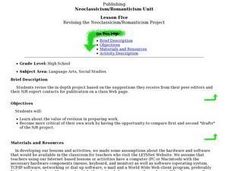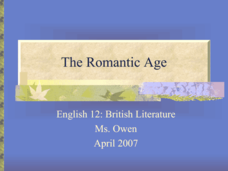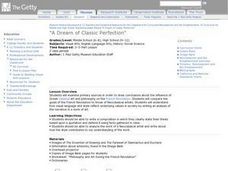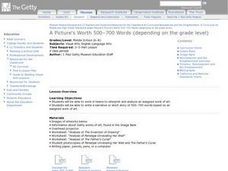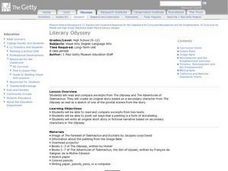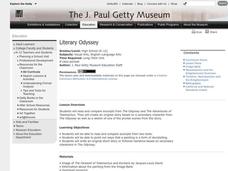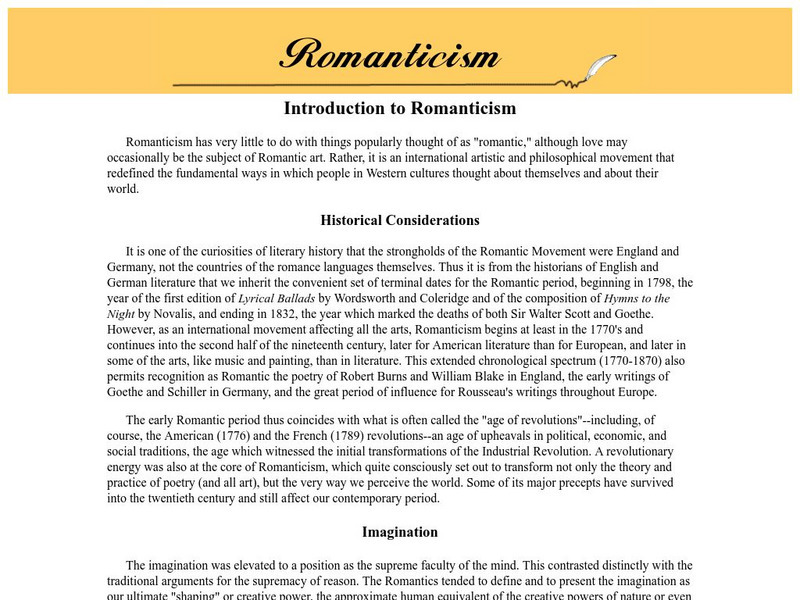Curated OER
Investigating Neoclassicism/Romanticism
Learners practice accessing and evaluating Internet resources as they perform research and answer, in written form, a series of general and specific questions about Neoclassicism/Romanticism.
Curated OER
Investigating Neoclassicism/Romanticism
Students use the internet to research neoclassicism and romanticism. Using various websites, answer a series of comprehension questions on the topic. They develop a presentation and share their information they gathered with their...
Curated OER
Revising the Neoclassicism/Romanticism Project
Young scholars revise the in-depth project based on the suggestions they receive from their peer editors and their N/R expert contacts for publication on a class Web page.
Curated OER
Introduction to Neoclassicism and Romanticism
Young scholars research the Internet to answer questions about Neoclassicism and Romanticism.
Curated OER
The Romantic Age in British Literature
Put the Romantic Age into context for British Literature classes with a PowerPoint that defines and characterizes this movement in literature, music and art. Notable painters, writers, and musicians are listed, as are key romantic themes...
Curated OER
Critiquing the Neoclassicism/Romanticism Project
Learners request feedback on their projects from Neoclassicist/Romanticist experts they have contacted via e-mail or other means. They work in pairs to critique each other's work.
Curated OER
Selecting the Focus of the Neoclassicism/Romanticism Project
Students identify and flesh out an area of particular interest to them in the field of N/R for the purpose of developing and submitting a more in-depth project on that area of interest.
Curated OER
Further Study of Neoclassicism and Romanticism
Students continue to conduct Internet research to answer the remaining N/R questions. They are encouraged to contact and communicate with N/R professors or other experts, either singly or over e-mail discussion lists.
Curated OER
Goddesses Are Personifications Too!
Students discover the use of personification as a way of expressing ideals. In this Language Arts lesson, students create an allegorical depiction of a contemporary ideal. Students write labels that clearly support the...
Curated OER
British Romanticism: An Introduction to the Social/Cultural Contexts
The major tenets of British Neoclassicism and Romanticism are listed in a presentation that also notes the significant consequences of industrialization. No context is provided for the slides of the paintings.
Curated OER
A Picture's Worth 500-700 Words: Neoclassical Painting Analysis and Creative Write
Students survey Neoclassical art and create a narrative based on their analyses. Focused questions and relevant background information provided by the Getty Museum provides a great foundation for students to understand art techniques as...
Curated OER
A Dream Of Classic Perfection
Students examine primary sources in order to draw conclusions about the influence of Greek classical art and philosophy on the French Revolution. They compare the goals of the French Revolution to those of Neoclassical artists.
Curated OER
A Dream of Class Perfection
Students discover the influence of Greek classical art and philosophy on the French Revolution. In this art lesson, students analyze a Neoclassical artist and write an essay in which they discuss how the style contributes to the...
Curated OER
Literary Odyssey
Students read and compare excerpts from The Odyssey and The Adventures of Telemachus. In this literary comparison lesson, students read the two stories and discuss the characters Telemachus and Eucharis. Students view an image by David...
Curated OER
A Picture's Worth 500-700 Words
Students interpret and analyze a work of art and write a narrative for the piece of art. In this narrative art instructional activity, students analyze a work of art and then write a short story 500-700 words long to narrate the art.
Curated OER
Literary Odyssey
Students read and compare excerpts from The Odyssey and The Adventures of Telemachus. They create an original story based on a secondary character from The Odyssey as well as a sketch of one of the pivotal scenes from the story.
Curated OER
A Picture's Worth 500-700 Words
Students write a narrative or short story of 500-700 words based on an assigned work of art.
Curated OER
Literary Odyssey
Students read and compare excerpts from The Odyssey and The Adventures of Telemachus to create their own story based on a secondary character. In this literary analysis lesson, students read and compare the excerpts from the...
British Library
British Library: Discovering Literature: Neoclassicism
Writers and craftsmen including Alexander Pope, John Dryden, Jonathan Swift, and Josiah Wedgwood found inspiration in the classical period. This article explores how their works adopted the style, genres, aesthetic values, and subjects...
City University of New York
Brooklyn College: Melani: Romanticism: Introduction to Romanticism
This is an article discribing Romanticism and the Romantic Period from 1798-1832 including its beginning with the publication of Lyrical Ballads by Wordsworth and Coleridge. Characteristics include heightened imagination, nature...
University of Groningen
American History: Outlines: Neoclassism: Epic, Mock Epic and Satire
Unfortunately, "literary" writing was not as simple and direct as political writing. When trying to write poetry, most educated authors stumbled into the pitfall of elegant neoclassicism. The epic, in particular, exercised a fatal...
University of Houston
University of Houston: English Romanticism
This webite on English Romanticism by Elizabeth Whitney focuses on the Romantic period including defining Romanticism, the history and politics, the Romantic poets, visual arts, and music. It also offers a link to the radio program "The...
British Library
British Library: Discovering Literature: Language and Ideas
From Johnson's Dictionary to letter-writing, newspapers and coffee-house culture: explore how different forms and mediums helped to develop and circulate language and ideas during the long 18th century.
British Library
British Library: Discovering Literature: Satire and Humour
Discover how writers of the 17th and 18th centuries used satire and humour to address issues around politics and power, inequality and class, gender and marriage - as well as to entertain readers and audiences.
Other popular searches
- Romanticism Neoclassicism
- Neoclassicism Questions
- Assessment of Neoclassicism
- Questions on Neoclassicism
- Neoclassicism &Enlightenment
- Art History Neoclassicism


